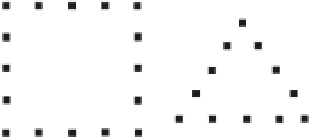Geology Reference
In-Depth Information
D
D
D
D
Figure 14.2
Examples of symmetric 2D arrays for passive surface-wave
surveys. D is the array maximum dimension and is related to the depth
of investigation. The geophone spacing determines the minimum depth of
investigation.
A range of symmetric 2D arrays has been tested by the Kansas Geological
Society and Figure 14.2 shows examples suitable for random-source MASW
surveys.
14.1.4 Survey design
As a rule of thumb, the longest wavelength that can be detected, which in turn
determines the maximum depth of investigation, is equal to the length of the
geophone spread,
D
. The geophone spacing defines the shortest wavelength
that can be detected and the shallowest depth of investigation. Near-field
source effects are important and must be avoided, but there is currently little
agreement concerning the minimum safe distance. Estimates vary between
D
/
5and
D
/
2.
A typical record length for an active-source survey is 2 s, with a 0.5- or
1-ms sampling interval, but this may be increased over particularly slow
materials. Records are stacked to maximise the signal-to-noise ratio (SNR).
Passive surveys generally require multiple records, each of the order of 30 s
long, sampled at intervals certainly no longer than 4 ms and preferably 2 ms.
These records cannot be stacked.
The ReMi approach of combining random passive sources with untimed
'active' sources, typically sledgehammers, to increase the high-frequency
content has proven very effective and can be preferable to carrying out
separate active and passive MASW surveys, which might well require more
time on site than is actually available. Geophone land streamers (see Section
11.3.1) are now being routinely used to maximise the productivity of linear-
array surveys over relatively smooth surfaces, using both controlled and
random sources. Geophones with resonant frequencies of 4.5 Hz or less
are needed to get 50-m depth penetration, depending on the subsurface
materials. For a 100 m depth, 1-Hz geophones are normally required.
































